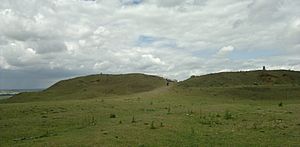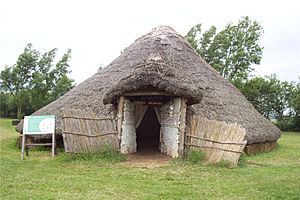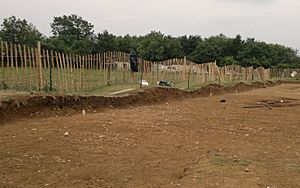Burrough Hill facts for kids
Quick facts for kids Burrough Hill |
|
|---|---|
| Burrough on the Hill, Leicestershire | |

The main entrance to the hillfort
|
|
| Coordinates | 52°41′59″N 0°52′32″W / 52.699754°N 0.875517°W |
| Type | Iron Age hillfort |
| Site information | |
| Owner | Ernest Cook Trust |
| Controlled by | English Heritage |
| Condition | Earthwork remains |
Burrough Hill is an ancient hillfort from the Iron Age. It is located in Burrough on the Hill, about 7 miles south of Melton Mowbray in Leicestershire, England. This hillfort sits on a high point, about 210 meters (690 feet) above sea level. From here, people could see for miles around.
People have lived in this area since at least the Mesolithic period, which was a very long time ago. The hillfort itself was built in the early Iron Age. After it was no longer used as a fort, the hill became farmland in the medieval period. You can still see lines in the ground called ridge and furrow from where farmers ploughed their fields.
Since the 1930s, archaeologists have been studying Burrough Hill. New digs by the University of Leicester started in 2010. Today, Burrough Hill is part of Burrough Hill Country Park and is open to everyone. It is also a Scheduled Ancient Monument, which means it's a very important historical site.
According to archaeologist Dr. Jeremy Taylor, places like Burrough Hill were the closest thing to a town before bigger cities like Leicester existed.
Contents
What is Burrough Hill Like?

The hillfort is built on a rocky outcrop called an ironstone promontory. This spot is about 200 meters (656 feet) above sea level. The rocks here are a type of limestone that contains iron, which gives them an orange to light brown color.
The hillfort is shaped like a trapezoid and covers about 4.8 hectares (12 acres). It is surrounded by a single ditch and a large bank, called a rampart. These ramparts were made from stone and earth. They are still about 3 meters (10 feet) high today, but they would have been even taller when they were first built.
How Did People Get In?
The main way into the hillfort was from the south-east. The entrance was a long, winding path about 45 meters (148 feet) long. It was protected by high banks, which were probably covered with stone. There might have been a small room, like a guardhouse, built into these banks. Wooden posts suggest there was a wooden walkway above the entrance. This design made it harder for enemies to get inside quickly.
Archaeologists think there might have been another entrance on the south-west side. Even though some parts of the ramparts have been damaged over time, most of the fort's defenses are still well preserved.
What Was Inside the Fort?
In 2010, a special survey using magnets found over 400 circular shapes inside the hillfort. These were probably storage pits where people kept food. The survey also found curved shapes, which are likely the remains of roundhouses. These were homes where people lived. The roundhouses were mostly found near the ramparts on the north, west, and south sides.
Outside the main entrance, there are signs of old quarries where people dug for stone after the fort was no longer used. More curved shapes were found outside the hillfort, suggesting there was also a settlement with roundhouses outside the main walls. This outside settlement was also protected by a ditch.
A Look at Burrough Hill's Past
Burrough Hill is a great example of a "univallate hillfort" in Leicestershire. This means it was surrounded by a single ditch and rampart.
Early Days and Roman Times
Things found at the site show that people have been active here since the Mesolithic period. However, a proper settlement probably started in the Late Bronze Age or Early Iron Age. We don't know exactly how the hillfort developed over time.
The busiest time at Burrough Hill was between 100 BC and AD 50. Artifacts found here show that the people living in the fort traded with many other places. Towards the end of the Iron Age, the fort slowly became less important. Roman pottery found at the site suggests it was still used between the 1st and 4th centuries AD, when Britain was under Roman rule. During the Roman period, most people lived in the northern part of the fort.
Medieval Farming and Fun

In the medieval period, the inside of the hillfort and the land around it were used for farming. You can still see the marks of ridge and furrow from where fields were ploughed. Besides farming, local people also used the hill for fun events.
A writer from the 1500s, John Leland, wrote that on Whit Mondays, people would gather on the hill for dancing and games. He even dug into some of the earthworks near the entrance out of curiosity. This makes his notes one of the earliest reports of archaeological digging! The hill was farmed until the 1600s. In the 1800s, Burrough Hill was used for horse races called steeple-chasing.
Archaeological Discoveries
The first professional archaeological dig at Burrough Hill was in 1935. It wasn't well recorded, but it found animal bones and pieces of Iron Age and Roman pottery.
More excavations happened in 1960. By then, new tools like magnetometers could be used to survey the ground without digging. This survey helped archaeologists find many features, which turned out to be storage pits. They found animal bones, stones for grinding grain, and more pottery. The entrance was also studied, revealing a cobbled path and possibly a guardhouse. A brooch from the La Tène culture was also found.

In 1967, more digging took place, focusing on the pit-like features found earlier. They found Iron Age and Roman pottery, animal bones, and charcoal. Roman pottery and coins from the 200s and 300s AD were found in the topsoil. More digs in 1970 and 1971 also found interesting things. Even with all these digs, much about the hillfort is still a mystery because the results haven't been fully shared.
Burrough Hill Today
The country park that includes the hillfort covers about 35 hectares (86 acres). The Ernest Cook Trust owns the site, and Leicestershire County Council has leased it since 1970. The land is still used for farming, mostly for crops, but also for cows and sheep. Burrough Hill Country Park is open to the public during daylight hours.
In 2010, a five-year excavation project began at Burrough Hill. It was led by the University of Leicester. Archaeologists wanted to learn more about the purpose of hillforts in the region. The digs also helped train university students.
The project leader, John Thomas, shared some exciting finds after the first three years. They found many objects in large storage pits that had been filled with rubbish. These included about 100 Iron Age metal items, which is one of the largest collections from this part of England! They also found a bone dice, gaming pieces, a polished bone flute, and a beautiful blue glass bead from a necklace. These finds are very different from what is found at smaller farmsteads, suggesting that people at Burrough Hill had a higher status and access to more interesting things.



